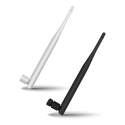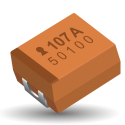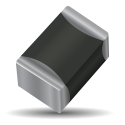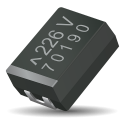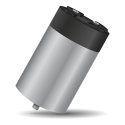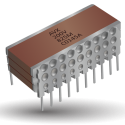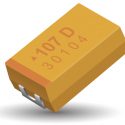LCD Driver Circuit EMI Filtering Options Written By: Ron Demcko Abstract: A review of EMI filter component options, comparing product performance, device characteristics and related factors (eg PCB board area, placement cost, etc.).
Resources
Equivalent Circuit Model for Tantalum and Niobium Oxide Capacitors for use in Simulation Software Written By: J. Pelcak Abstract: In electrical circuit simulations with simulation software, ideal passive components (resistors, capacitors, inductors) are typically used because real component characteristics have been difficult to model. Unfortunately, ideal and real passive components have significant differences in their electrical behavior. These differences lead to discrepancies between actual hardware performance and expected results based upon simulation software programs. This paper will describe the development of equivalent circuit diagram for modeling real capacitor behavior. Use of this real model in simulation software can help make circuit development more efficient, as the circuits in the simulations should have similar behavior to the actual circuits. The model
How to Choose the Correct Accu-Guard Fuse for Circuit Protection Written By: Irina Daynov | Barry Breen Abstract: The ACCU-GUARD is designed to meet the need of electronic circuits for a small, accurate surface mount fuse. This article presents design guidelines for achieving optimal protection of circuits with ACCU-GUARD. All major parameters are described including operating temperature, circuit voltage, fault current, steady state current and current pulses (Joule integral).
Bluetooth and Antenna Matching Written By: Ron Demcko Abstract: Antenna matching is an important aspect of any RF system. A properly designed and matched antenna increases the operating distance of the wireless product. Well matched antennas can transmit more power from the radio – therefore transmit over longer distances. Likewise, a well matched antenna allows the maximum transfer of energy from the receiving antenna to the receiver front end. Thus, allowing better receive characteristics for the system. Antenna matching becomes critical as antennas are reduced in size and placed in small modules that can experience wide temperature ranges and potentially have foreign objects in proximity. This paper discusses one class of intermediate Q capacitors used for SMT antenna matching
Capacitor Selection and EMI Filtering Written By: Jeffrey Cain | Steve Makl Abstract: MLCCs are an inexpensive, yet effective, method for reducing the noise on both power/ground systems and signal lines themselves. Choosing the proper capacitance value such that the impedance is minimized at the frequency of interest also makes a difference.
Conductivity Mechanisms and Breakdown Characteristics of Niobium Oxide Capacitors Written By: J. Sikula | J. Hlavka | V. Sedlakova | L. Grmela | P. Hoeschl | T. Zednicek | Z. Sita Abstract: Niobium Oxide capacitor, has already found its place in the market as a cost effective and reliable non-burning component. The study of conductivity mechanisms has been done to prove its excellent stability, reliability and non-burning performance. Set of electrical measurements as VA characteristics in forward and reverse mode, frequency characteristics of capacitance, temperature or time dependence of basic parameters together with measurements of basic physical parameters enabled to propose the theoretical model of NbO – Nb2O5 – MnO2 system. NbO Capacitor shows identical conductivity mechanism as tantalum capacitor,
AVX Staticguard Performance Comparison to SOT-23 SMT Diodes Written By: Ron Demcko Abstract: AVX StaticGuard is designed to provide transient protection for MSI to VLSI CMOS circuitry. This article presents performance characteristics of low energy MLV transient voltage suppressors relative to low energy silicon diodes. All major parameters are described, including leakage current, clamping voltage, capacitance, peak current and repetitive strike performance. AVX StaticGuard is shown to have superior performance to SOT 23 diodes in transient suppression applications.
Basic Guidelines of Conductive Polymer Capacitors Written By: S. Zedníček | J.Petržílek | P.Vanšura | M.Weaver | C.Reynolds Abstract: Conductive Polymer Capacitors are relatively new solid electrolytic capacitor technology on the market. The range of application is growing also due to their low ESR and safe operational characteristics. The paper addresses frequently asked questions about construction, parametric performance, product life, product specifications, recommendations and applications.
Using High-Directivity Couplers in Isolatorless Cellular Phone PA Control Written By: Avital Yaish Abstract: This article outlines the use of High-Directivity Couplers in Cellular handsets. Benefits can include increased talk-time, minimized insertion loss between the PA and the antenna and can also remove the need for an isolator. A version of this article was previously published in RF Design, April 2006.
AVX EMI Solutions Written By: Ron Demcko | Chris Mello | Brian Ward Abstract: EMC compatibility is becoming a key design parameter for a most designers of electronic systems. This paper compares the efficiency and effectiveness of various EMI filter options available to designers. Integrated Thick Film LC T filters are shown to be a cost effective method to improve board level EMC performance while shrinking system design size and keeping costs minimized. A general recap of EMI sources is given as well as a brief recap of PCB layout and optimization rules.
Thin-Film Passives in RF/Microwave Circuits Written By: Ron Demcko Abstract: Until recently, most microwave capacitors were based on fired multilayer ceramic technology. In this process, layers of highly conductive electrode metal alloys are interleaved with low-loss ceramic dielectrics in a multilayer fashion until the target capacitance is obtained. The resulting stack is then sintered into a monolithic structure in a high-temperature firing process. This process continues to satisfactorily serve highpower capacitor needs in addition to those in larger value RF capacitors…
Evolution of Power Capacitors for Electric Vehicles Written By: Gilles Terzulli Abstract: Electric vehicles are in widespread use. Hybrid cars are now a common sight on our roads as people look to find more environmentally-friendly forms of personal transport, and there are many other commercial and public electric vehicles, such as trains, trams, buses and industrial trucks and equipment in everyday use. The electronic systems and components that have enabled the realisation of such a wide variety of electric vehicles have all experienced a major evolution, including the DC link power capacitor. The purpose of capacitors in electric vehicles is to prevent ripple currents from reaching back to the power source, and to smooth out DC bus voltage variations. Capacitors
Capacitors for High Temperature Applications Written By: Martin Barta | Slavomir Pala | Stanley P. Cygan Abstract: Traditionally, the main market for high temperature electronics is the downhole oil and gas industry. However, the avionics, automotive and many other industries also have applications which share the same key requirements of reliability under harsh operating conditions, including high humidity and dust, and the ability to withstand shock and vibration. Resistors and capacitors are ubiquitous in any electronic device and system. The lack of reliable hightemperature, high value capacitors has almost certainly limited growth in these newer applications. Most current capacitor technologies on the market, such as aluminium electrolytics or film capacitors, are limited to a maximum temperature range of 125ºC –
A Multilayer Approach to Transient Voltage Supressors Written By: John Maxwell | Ning Chan | Allen Templeton Abstract: Improvements in integrated circuits have resulted in increased speed and increased ESD sensitivity. New systems require external protection more than ever before but advances in surface mount technology and product miniaturization place severe size constraints on protection components. Advances in ceramics now allow transient voltage suppressors to be built with multilayer structures resulting in improved electrical performance and in smaller sizes than comparable disc configurations. Clamping voltage and peak current performances approaching zener diode transient suppressors are achieved in the common 1206 (3.2 x 1.6mm) chip size, one third the size of SMT disc varistors or SMT zener diode supressors.
The Accu-L Multi-Layer Inductor for High Frequency Applications Written By: Barry N. Breen | Chaim Goldberger | Leonid Talalavsky Abstract: The telecommunications industry today is undergoing changes. The miniaturization of electronic circuits and the use of higher frequencies in radio communication systems such as Cellular Telephones, PCN and GPS places new demands on passive components. High frequency inductors have not kept pace with the demands. AVX has responded to these requirements by putting to market a miniature (0805) high frequency SMD inductor based on thin film technology. This article presents the basic concepts of high frequency inductors and how such low value inductors are measured and characterized. Here, too, there is a lag between the high frequency designer’s need for
Basic Tantalum Capacitor Technology Written By: John Gill Abstract: This paper covers the general manufacturing techniques used to make a solid tantalum capacitor. The purpose of this paper is to give the layperson an understanding of current tantalum technology.

